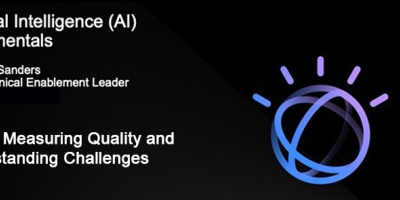As AI algorithms become more complex and increasingly mimic human behavior, questions arise about how to ensure AI systems behave as ethically as humans are expected to. This two-part series examines some of the major AI ethical dilemmas and the efforts to find solutions.
Designing software has always been straightforward in certain ways, no matter what kind of application a developer is trying to create. The designer looks to accomplish a set of tasks and pass resulting information on to another program and, ultimately, other humans. As long as results are accurate, the issue of whether an algorithm’s output is going to be used in an ethical way is passed over as being, perhaps rightfully, beyond the software designer’s control.
AI systems, though, add the expectation that with minimal human oversight, a mature algorithm will function more or less autonomously and produce results that can have much wider-ranging impacts than, say, an accounting program that’s simply cranking out someone’s monthly bill. Even though AI systems “learn” to function by processing datasets until they produce what some human user classifies as a “desired” result, an AI system’s ultimate learned behavior can diverge from a designer’s intended outcome. When that happens, what’s the appropriate remedy, and who is responsible if some kind of damage occurs?
My Computer Did It
Probably the most notorious example of what can go wrong and the dilemmas that failure presents was the autonomous automobile that struck and killed a California pedestrian. The car contained a human who was merely a passenger and not operating the vehicle. Who is liable for the pedestrian’s death? The car’s occupant, who was as close to a driver as most people can imagine in a vehicular accident? The car’s owner? The car’s builder? The person who designed the car’s AI? All four? Except then, in what proportion was each party responsible? Surely the helpless passenger wasn’t as responsible as whoever designed the AI. Oh wait, maybe it was the person who designed the car’s CPU.
“What a dilemma,” most people murmur as they turn their attention to something else. The trouble is, this situation is just the tip of the iceberg. It’s not even an outline of the problem. Another few seconds of thinking about an autonomous car shows why.
Suppose you’re in an autonomous car that’s heading down a mountain road. To your right are the guardrails that keep you from plunging 1,000 feet if the car should veer off the road. To your left is a rock wall that’s part of the mountain and in the left lane are some bicyclists heroically pumping their way up the hill. Just then you realize the car is speeding up uncontrollably. You can’t tell, but it’s because all the hydraulic fluid leaked out of your braking system after you hit that rock in the road a mile back. The car itself doesn’t know what happened. What should your AI have been programmed to do?
Pull off the road to the right? Nothing there but guardrails and 10 seconds of weightlessness until you hit bottom. Pull off the road to the left? You’ll hit solid rock at high speed and probably kill a bicyclist or two in the bargain. Keep going straight until the road curves and you go through the guardrails anyway? That’s the ticket. Hey, you’re the one who made the decision to go for a ride in an autonomous car! Shouldn’t it be your neck at risk rather than some innocent bicyclist’s? Fair’s fair, right?
What, you don’t agree?
AI Ethical Dilemmas Abound
When a system becomes autonomous, it can become a moral actor, just like a human being. The system has to interact with a world that’s full of other moral actors and situations calling for ethical decisions. So how do you program an AI to make ethical judgements? That’s a whole lot more complicated than looking up how many widgets are left in the warehouse when somebody orders one. Yet that’s what designing an AI system today must take into account. What’s worse, there’s a long list of other examples of ethical problems AIs and their human designers must face that have nothing to do with autonomous cars. And that’s assuming that we can all agree on what the word “ethical” really means and that it has anything to do with “morality.” Fat chance? Welcome to the world of AI ethics and the growing awareness that it’s anything but a problem that can be solved by careful coding.
To see how pervasive the ethical challenges in AI really are, let’s take a look at some other examples.
National governments have had weaponized drones for some time. AI is being used by some of them to let weaponized drones make decisions about when or when not to use those weapons. That makes firing those weapons a life-or-death decision being made by an AI. Any moral concerns there? Now even hobby drones have become weaponized. A reckoning in this area seems inevitable.
Widespread use of some AI facial-recognition software is being criticized for misidentifying persons of color up to 100 times more often than misidentifying white men. China is being blamed for using facial-recognition software to track its citizens and oppress its Uighur minority. Is using faulty software to gather data for making law-enforcement or other decisions really okay, to say nothing of the potential political issues of loss of privacy and fostering a technology that potentially supports government authoritarianism? A Facial Recognition and Biometric Technology Moratorium Act has been introduced in the U.S. Congress to put the brakes on this kind of tech indefinitely. It probably won’t pass, but any time U.S. federal legislators get involved, you know something’s become an issue that’s not confined to the IT world anymore.
Amazon had to pull back an AI-based human resources app that scanned resumes when it turned out that the algorithm discriminated against women candidates. Was that discrimination done purposefully? Probably not, but no one saw it until Amazon had gotten embarrassed publicly. There have been incidents of similar complaints about AI apps that, for example, decide who might be eligible for a bank loan. Machine learning is only as good as its training datasets. In the Amazon case, no one noticed the bulk of the dataset used to train that HR app were resumes from men and the app came to “prefer” resumes from males.
AI runs on software, which can often be hacked with enough skill and persistence. What would happen if an AI that was making life-or-death decisions about using weapons or deciding how to prioritize medical treatments during a large-scale event like, oh say, a pandemic, got hijacked by someone malicious and altered to do something other than what it was supposed to do? That might cross an ethical boundary at the very least.
Reproducibility is another issue clouding AI’s future. This refers to a growing problem in which a significant number of research papers on all topics (including AI) were found to have their conclusions unverifiable when other researchers tried to duplicate reported results. When first reported in 2016, the failure rate was as high as 70 percent.
Although it’s already underway, widespread AI automation could eventually eliminate whole categories of jobs. Cashiers, for example, have been partly displaced by automated checkouts at the grocery stores in recent years, and there are many other examples of job types that could vanish wholesale in the near future. How will our society cope with this additional spur to large-scale unemployment? Is there any responsibility for ameliorating that? Or do we simply print more money or build more prisons and homeless shelters? Is this an ethical question or merely a political one?
AI apps buy and sell huge blocks of stock in nanoseconds based on unscripted daily events. Could AI be used for equities manipulation or some other financial conspiracies somehow? Only if we put too much faith in automated systems—but that won’t really happen, will it?
It’s conceivable that eventually at least some personal-care specialists are going to be robotic. Are these caregiving robots going to seem empathetic, or will their programming reach the point where they actually are empathetic? If the latter, is that close enough to being human that the robots will actually deserve some human rights? Could a person receiving care from a robot come to form an emotional attachment to it? Could such a person be manipulated by an intelligent robot or its controller? What are the implications of that? It seems all of these scenarios could be viewed as ethical questions.
There are dozens of identified cognitive and memory biases that affect human beings. Logic dictates that there can’t be more than a handful of AI developers and machine-learning specialists who are free of all of them. It’s inevitable that some of those are going to carry over into AI apps, either because of the way the apps are structured to operate or because of the data the apps are given to train them. How do designers avoid a bias they can’t even see in themselves from carrying over into an AI project?
A similar challenge is that some tech companies are “offshoring” the whole ethics question: “Let the developers in Mumbai handle it.” The problem this creates is that, because there are potentially significant cultural differences between developers in different countries, subconscious biases from that source may creep into AI apps without being noticed or even looked for. A developer who grew up witnessing the sometimes chaotic-seeming traffic patterns in Mexico City, for example, might have a different mindset than someone else when it comes to programming autonomous cars to handle city traffic. Attitudes toward women, racial or religious minorities, or those relatively disadvantaged economically, for instance, vary widely in the U.S. alone. Looking to developers from a different culture to sort out these issues adds a whole new level of complexity. Who then gets to define what is “ethical?”
These Problems Are Not Insurmountable
There are other ethical concerns we could get into, but what we’ve dealt with so far are enough to show how AI ethics challenges are more broad-based than they initially may appear and that they deserve to be the subject of widespread concern and examination. Suffice it to say there are too many ways for AI to go unintentionally wrong before we even get into addressing malicious manipulation.
The good news is that a number of solid remedies have been proposed and a number of professional organizations are springing up to address this concern and help educate IT professionals and the public in general about pitfalls. In Part Two of this two-part series we’ll review these and see how they are trying to address the ethical dilemmas that are clouding an otherwise fertile and promising future for AI.























 More than ever, there is a demand for IT to deliver innovation. Your IBM i has been an essential part of your business operations for years. However, your organization may struggle to maintain the current system and implement new projects. The thousands of customers we've worked with and surveyed state that expectations regarding the digital footprint and vision of the company are not aligned with the current IT environment.
More than ever, there is a demand for IT to deliver innovation. Your IBM i has been an essential part of your business operations for years. However, your organization may struggle to maintain the current system and implement new projects. The thousands of customers we've worked with and surveyed state that expectations regarding the digital footprint and vision of the company are not aligned with the current IT environment. TRY the one package that solves all your document design and printing challenges on all your platforms. Produce bar code labels, electronic forms, ad hoc reports, and RFID tags – without programming! MarkMagic is the only document design and print solution that combines report writing, WYSIWYG label and forms design, and conditional printing in one integrated product. Make sure your data survives when catastrophe hits. Request your trial now! Request Now.
TRY the one package that solves all your document design and printing challenges on all your platforms. Produce bar code labels, electronic forms, ad hoc reports, and RFID tags – without programming! MarkMagic is the only document design and print solution that combines report writing, WYSIWYG label and forms design, and conditional printing in one integrated product. Make sure your data survives when catastrophe hits. Request your trial now! Request Now. Forms of ransomware has been around for over 30 years, and with more and more organizations suffering attacks each year, it continues to endure. What has made ransomware such a durable threat and what is the best way to combat it? In order to prevent ransomware, organizations must first understand how it works.
Forms of ransomware has been around for over 30 years, and with more and more organizations suffering attacks each year, it continues to endure. What has made ransomware such a durable threat and what is the best way to combat it? In order to prevent ransomware, organizations must first understand how it works. Disaster protection is vital to every business. Yet, it often consists of patched together procedures that are prone to error. From automatic backups to data encryption to media management, Robot automates the routine (yet often complex) tasks of iSeries backup and recovery, saving you time and money and making the process safer and more reliable. Automate your backups with the Robot Backup and Recovery Solution. Key features include:
Disaster protection is vital to every business. Yet, it often consists of patched together procedures that are prone to error. From automatic backups to data encryption to media management, Robot automates the routine (yet often complex) tasks of iSeries backup and recovery, saving you time and money and making the process safer and more reliable. Automate your backups with the Robot Backup and Recovery Solution. Key features include: Business users want new applications now. Market and regulatory pressures require faster application updates and delivery into production. Your IBM i developers may be approaching retirement, and you see no sure way to fill their positions with experienced developers. In addition, you may be caught between maintaining your existing applications and the uncertainty of moving to something new.
Business users want new applications now. Market and regulatory pressures require faster application updates and delivery into production. Your IBM i developers may be approaching retirement, and you see no sure way to fill their positions with experienced developers. In addition, you may be caught between maintaining your existing applications and the uncertainty of moving to something new. IT managers hoping to find new IBM i talent are discovering that the pool of experienced RPG programmers and operators or administrators with intimate knowledge of the operating system and the applications that run on it is small. This begs the question: How will you manage the platform that supports such a big part of your business? This guide offers strategies and software suggestions to help you plan IT staffing and resources and smooth the transition after your AS/400 talent retires. Read on to learn:
IT managers hoping to find new IBM i talent are discovering that the pool of experienced RPG programmers and operators or administrators with intimate knowledge of the operating system and the applications that run on it is small. This begs the question: How will you manage the platform that supports such a big part of your business? This guide offers strategies and software suggestions to help you plan IT staffing and resources and smooth the transition after your AS/400 talent retires. Read on to learn:
LATEST COMMENTS
MC Press Online